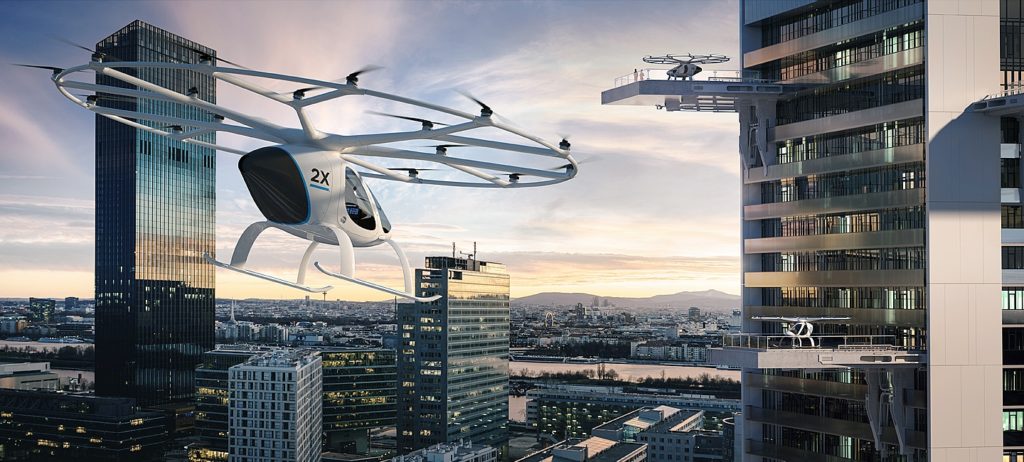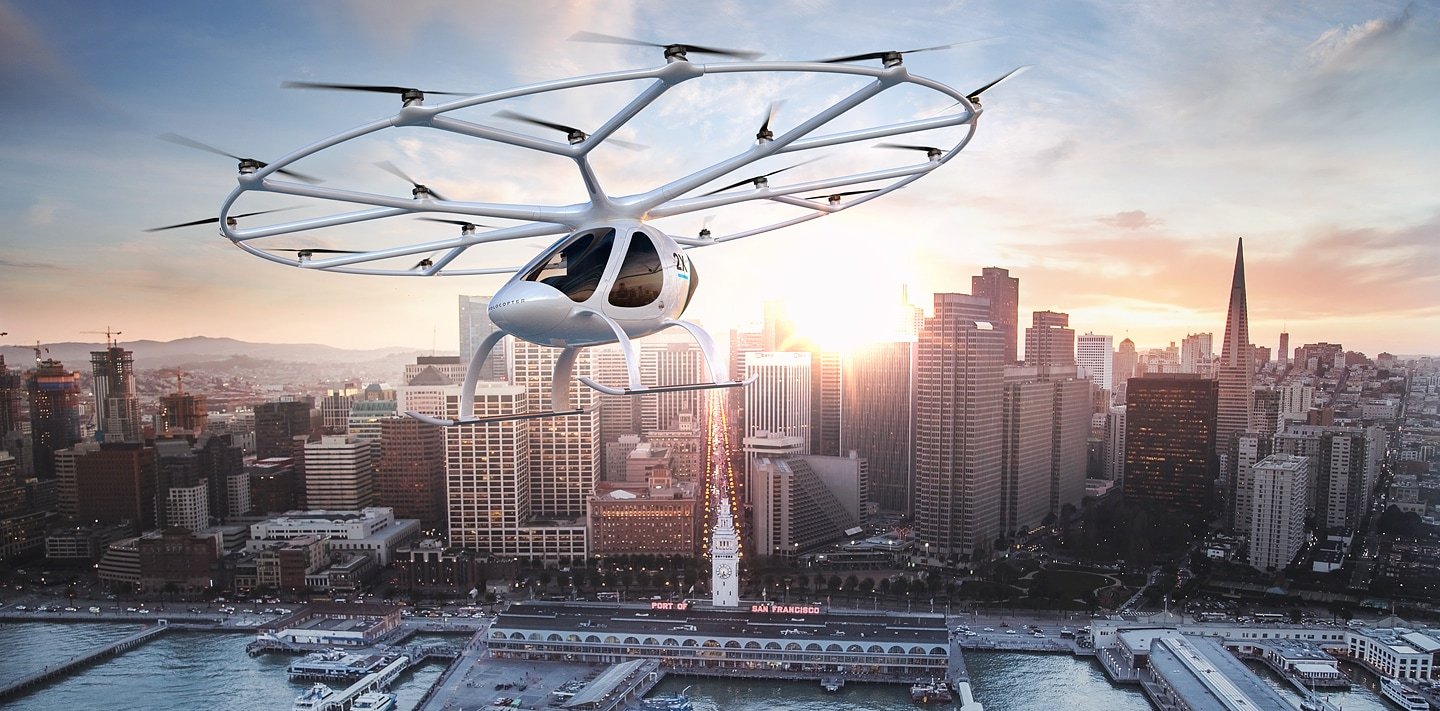In years to come, citizens will not only have the option to get a bus or a train to work in the morning; they’ll also be able to jump aboard an air taxi. This is what Alex Zosel, co-founder and chief innovation advisor of German aviation startup Volocopter, imagines life will look like in the cities of the future.
Based in Bruchsal, Germany, Volocopter have developed the first fully-electric and safe-vertical take off and landing (VTOL) aircraft in the world that can carry up to two passengers for a short distance. As cities across the globe rush to find solutions to alleviate their overloaded public transport services, air taxis present a faster, safer and more environmentally-friendly way of getting around.
In 2017, Volocopter made aviation history by carrying out a successful autonomous air taxi flight in the inner-city of Dubai. With further tests scheduled in Singapore in the latter half of 2019, Alex is confident that Volocopter will have their first commercial routes up and running in the next three to five years.
I caught up with Alex at Tech Open Air, Berlin’s largest interdisciplinary technology conference, to chat more about the challenges and rewards of developing air taxi transport services in megacities worldwide and Volocopter’s vision for the future of urban mobility.
Hi Alex, it’s great to see you here at Tech Open Air. I hope that the conference has been going well for you so far. Can you start us off by explaining more about Volocopter?
At Volocopter we are building air taxis that are safe, quiet, fully electric and emission-free as an alternative method of transportation. At the moment, we are developing the fourth generation of our aircraft which will comply with the operational requirements of safety and security for this type of vehicle.
Since 2018, we’ve also been working closely with the authorities in several different countries in order to build an infrastructure for our air taxis in inner-cities. Ultimately, we want the Volocopter to be a sustainable and time-saving mobility-as-a-service solution that can be used by everyone in megacities worldwide.
What are the challenges associated with developing air taxis?
I think the biggest challenge is being able to demonstrate that air taxis are safe. The new regulations from the International Civil Aviation Organization (ICAO) suggest that a two or four-seater air taxi has to be as secure as a commercial airliner that carries several hundred people. Unlike traditional helicopters, air taxis have to comply with quite stringent safety rules.
Another challenge is producing an aircraft that is quiet so that we can fly in inner cities without disturbing anyone. This is a very key consideration for us when it comes to successfully implementing our services in the future.
Are there any clear benefits of using air taxis in cities?
I think the biggest advantage of using air taxis is that it saves time. In São Paulo, for example, the city is very heavily congested with traffic so it takes much longer to drive somewhere than it does to fly.
Flying is actually safer too. Having more air taxis and fewer cars on the road will allow transportation on the ground to move more easily and will reduce the levels of pollution.
What do you imagine will be the public’s reaction to using air taxis like Volocopter's?
Perhaps in the future when we have fully autonomous cars driving on the roads, people will become more used to the idea of taking an air taxi instead of a bus. However, the response we’ve had so far has been really positive. We're confident that we won't have any problems finding customers; our task is just to ensure that our air taxis are as safe as possible and comply with regulations.
Also, there are very few people that have actually had experience flying an air taxi. That’s why we’re trying to make the aircraft comfortable and easy to operate.
How will air taxis integrate into everyday city life?
Volocopter’s biggest focus right now is building up an infrastructure for mobility in the third dimension. Some cities have already begun to show interest in changing their building regulations to enable the use of air taxis, which has been really amazing to see. Real estate companies have also contacted us to ask about our specifications for landing pads for our aircraft, which will likely be on the rooftops of hotels or conference centers in major cities.

Overall, our aim is to integrate air taxis into existing transport infrastructure. The first Volocopter routes will likely connect main transportation hubs, such as airports and business parks, to city centers. For example, we currently have a project with Fraport AG, which is one of the biggest airport managers in the world. The idea is to link up our air taxi service with trains, buses and commercial airlines and provide a connection to and from Frankfurt Airport.
There will be a lot of changes in mobility in cities over the next few years and we want to be part of building a new ecosystem for air taxi providers.
What infrastructure will need to be put in place for air taxis to operate in cities?
In order for air taxis to integrate into existing city infrastructure, we need somewhere for them to take off and land. Our plan is to build several Volo-Hubs in each city that will act as a station where passengers can climb in and out of the aircraft. It will also be the place where the air taxi's batteries will be swapped automatically by robots.
Later this year, we have plans to build the first Volo-Port in Singapore which is basically an extension of the idea of the Volo-Hub. We imagine it to look like an airport lounge with a small landing pad where the air taxis can drop off and pick up passengers, as well as a customer service center and other facilities.
What's next for Volocopter over the next few years?
Few years, or few months? Things are moving very fast for us. Alongside our project with Singapore, we have test flights scheduled in Helsinki in August of this year where we will be flying for longer distances. We're also starting to look for cities worldwide where we can set up our first commercial routes. We are already negotiating with cities, potential partners and, of course, the major aviation authorities about infrastructure and air traffic management.
We want to be a global company and be able to provide air taxi services to every continent in the world. By the time I retire, which is in the next 12 to 13 years, I want Volocopter to have networks of services in at least 10 megacities across the world.
Thanks for your time Alex!
To learn more about Volocopter’s vision for future air taxi transportation, you can check out their website here.



Would you like to write the first comment?
Login to post comments